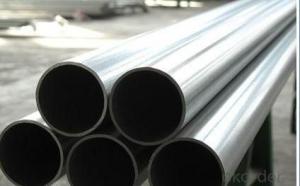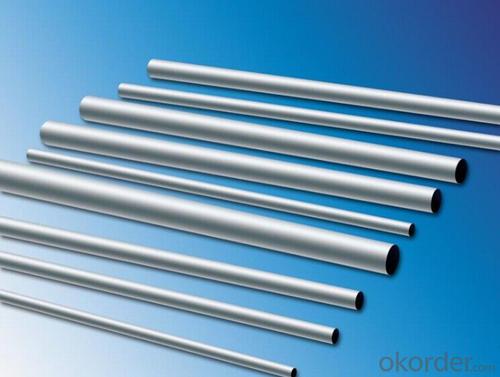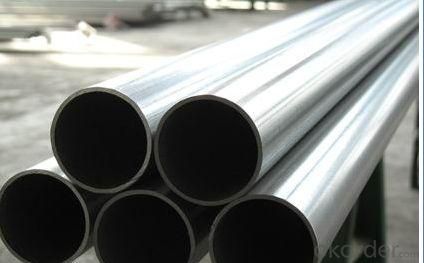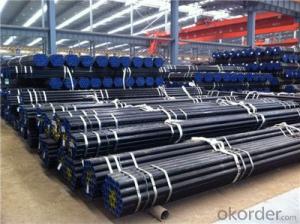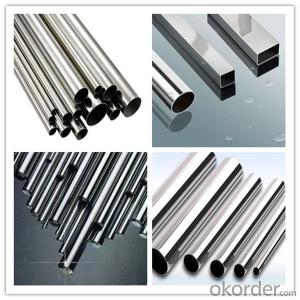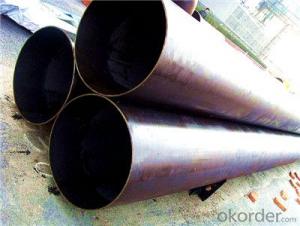304 Stainless Steel Pipe Clamp With Low Price
- Loading Port:
- Tianjin
- Payment Terms:
- TT OR LC
- Min Order Qty:
- 35 m.t.
- Supply Capability:
- 3000 m.t./month
OKorder Service Pledge
OKorder Financial Service
You Might Also Like
Specification
304 Stainless Steel Pipe Clamp with low price
1.Structure of Stainless Steel Pipe :
Stainless steel pipe is formed by drawing a solid billet over a piercing rod to create the hollow shell. As the manufacturing process does not include any welding, seamless pipes are perceived to be stronger and more reliable. Historically seamless pipe was regarded as withstanding pressure better than other types, and was often more easily available than welded pipe.
2.Main Features of the Stainless Steel Pipe :
• High manufacturing accuracy
• High strength
• Small inertia resistance
• Strong heat dissipation ability
• Good visual effect
• Reasonable price
3.Stainless Steel Pipe Specification:
Standard | GB, DIN, ASTM ASTM A106-2006, ASTM A53-2007 |
Grade | 10#-45#, 16Mn 10#, 20#, 45#, 16Mn |
Thickness | 8 - 33 mm |
Section Shape | Round |
Outer Diameter | 133 - 219 mm |
Place of Origin | Shandong, China (Mainland) |
Secondary Or Not | Non-secondary |
Application | Hydraulic Pipe |
Technique | Cold Drawn |
Certification | API |
Surface Treatment | factory state or painted black |
Special Pipe | API Pipe |
Alloy Or Not | Non-alloy |
Length | 5-12M |
Outer Diameter | 21.3-610mm |
Grade | 20#, 45#, Q345, API J55, API K55, API L80, API N80, API P110, A53B |
Standard | ASME, ASTM |
4. Application of Stainless Steel Pipe
Stainless steel pipe is used for structural and piping applications that require the properties that stainless steel delivers – high strength, toughness and excellent corrosion resistance. The pipe is available in sizes 1/2" through 36” in outside diameter (OD) and schedules 05S through 80S and larger for wall thickness (WT). It is available as welded and seamless. Stainless pipe has a dull gray, mill finish.
5.Packaging & Delivery
Packaging Details: | seaworthy package,bundles wrapped with strong steel strip |
Delivery Detail: | 50-60days after received 30%TT or Original LC |
6.FAQ of Stainless Steel Pipe :
A. How is the quality of your products?
Our products are manufactured strictly according to national and internaional standard, and we take a test on every pipe before delivered out. If you want see our quality certifications and all kinds of testing report, please just ask us for it.
Guaranteed: If products’ quality don’t accord to discription as we give or the promise before you place order, we promise 100% refund.
B.How about price?
Yes, we are factory and be able to give you lowest price below market one, and we have a policy that “ for saving time and absolutely honest business attitude, we quote as lowest as possible for any customer, and discount can be given according to quantity”,if you like bargain and factory price is not low enough as you think, just don’t waste your time.Please trust the quotation we would give you, it is professional one.
C.
Why should you chose us?
Chose happens because of quality, then price, We can give you both.Additionally, we can also offer professional products inquiry, products knowledge train(for agents), smooth goods delivery, exellent customer solution proposals.Our service formula: good quality+good price+good service=customer’s trust
SGS test is available, customer inspection before shipping is welcome, third party inspection is no problem.
Any question, pls feel free to contact us !
7. Stainless Steel Pipe Images:
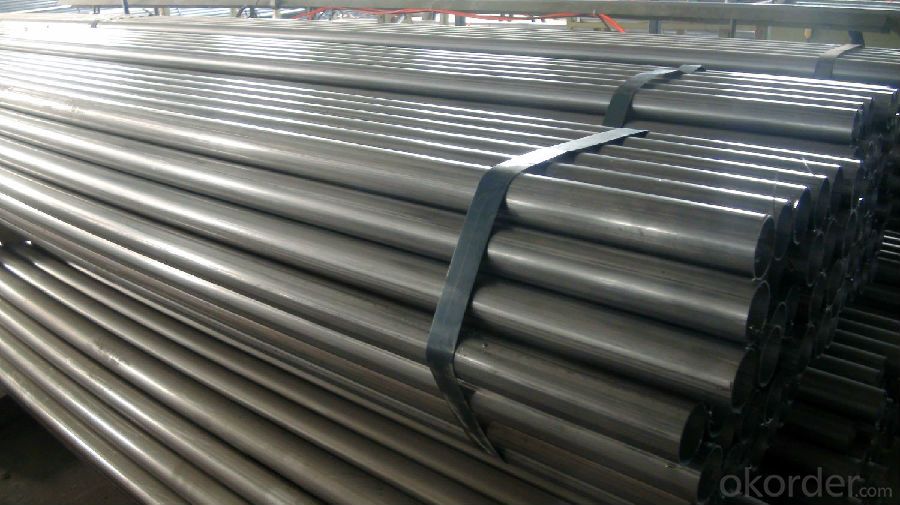
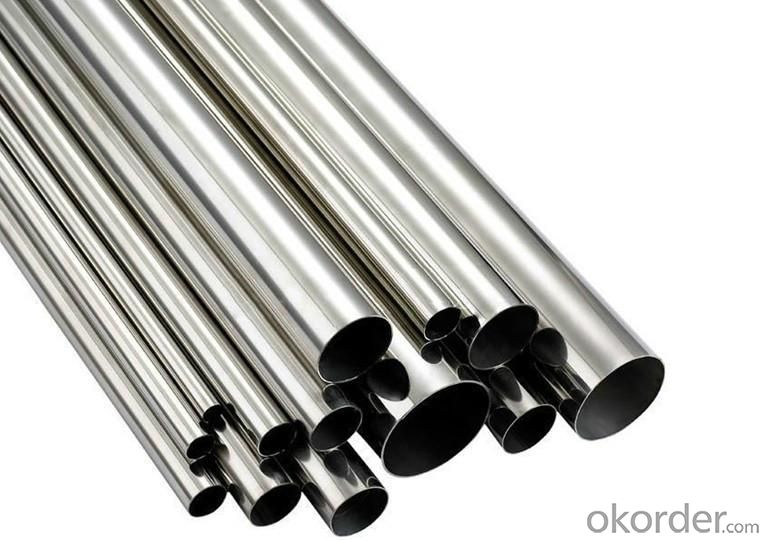
8. Company Information:
CNBM International Corporation (CNBM International) is the most important trading platform of CNBM Group Corporation, a state-owned company under the direct supervision of State-owned Assets Supervision and Administration Commission of the State Council.
Since 2004, the trading volume of CNBM International has been doubled in 5 successive years owing to the support of superior corporations and effort of all staff. Meanwhile, we have established strategic partnerships with hundreds of domestic manufacturers and sound business relations with clients from over 120 countries. Currently, we have wholly-owned overseas subsidiaries and branches in 5 countries with a view to realize localization, which also represents an essential progress in our globalization target.
In line with the business, CNBM International launched E-business platform Okorder.com.Our goal is to transform CNBM International into the global leading brand in building materials industry within 3 to 5 years through innovation and reform, by strengthening the overall management of supply chain, developing and cultivating both domestic and overseas market, improving the procedure and information system, enhancing the ability to organize resources and to provide value-added services under a professional team and a learning organization.
- Q: How do stainless steel pipes compare to polypropylene pipes?
- Stainless steel pipes generally have superior strength, durability, and resistance to corrosion compared to polypropylene pipes. They are suitable for high-pressure and high-temperature applications, making them ideal for industries such as oil and gas. On the other hand, polypropylene pipes are lightweight, flexible, and cost-effective, making them a popular choice for water supply and drainage systems. The choice between stainless steel and polypropylene pipes depends on the specific requirements of the application, budget, and other factors such as chemical compatibility and installation ease.
- Q: Can stainless steel pipes be used for fire sprinkler systems?
- Yes, stainless steel pipes can be used for fire sprinkler systems. Stainless steel is a highly durable and corrosion-resistant material, making it suitable for use in fire protection systems. It can withstand high temperatures and pressure, ensuring the reliability and longevity of the sprinkler system. Additionally, stainless steel pipes have a low thermal expansion coefficient, which reduces the risk of leaks or bursts due to temperature changes. These properties make stainless steel pipes a preferred choice for fire sprinkler systems in both commercial and residential buildings.
- Q: What is the difference between 316 and 316LN stainless steel pipes?
- 316 and 316LN stainless steel pipes are variations of the same stainless steel grade known as 316, but there are some distinctions between them. The primary disparity between 316 and 316LN stainless steel pipes resides in their nitrogen levels. 316LN stainless steel contains a higher nitrogen content than 316 stainless steel. The inclusion of nitrogen enhances the material's strength and corrosion resistance, making it more suitable for specific applications. Due to its elevated nitrogen content, 316LN stainless steel pipes display superior resistance to pitting and crevice corrosion, especially in chloride environments. This renders them particularly appropriate for utilization in marine settings or other scenarios where the pipes may encounter corrosive substances. Another contrast between the two grades lies in their availability and cost. 316 stainless steel pipes are more widely accessible and commonly employed, making them generally more cost-effective than 316LN stainless steel pipes. However, 316LN stainless steel pipes may be necessary for particular applications where enhanced corrosion resistance is required. In conclusion, the main difference between 316 and 316LN stainless steel pipes is their nitrogen content, which impacts their corrosion resistance properties. While 316 stainless steel is more readily available and cost-effective, 316LN stainless steel offers improved resistance to pitting and crevice corrosion, making it suitable for specific applications.
- Q: How do you calculate the expansion of stainless steel pipes?
- To calculate the expansion of stainless steel pipes, you need to consider the coefficient of thermal expansion of the material. This coefficient represents the change in length per unit length for every degree Celsius of temperature change. By multiplying the coefficient by the initial length of the pipe and the temperature difference, you can determine the expansion of the stainless steel pipe.
- Q: Is galvanized steel pipe stainless steel pipe?
- No, the steel pipe is generally divided into stainless steel pipe, welded steel pipe, spiral steel pipe, low alloy steel pipe and so on.
- Q: How do you protect stainless steel pipes from heat damage?
- To protect stainless steel pipes from heat damage, it is important to insulate them with materials that have high thermal resistance. This can be done by using insulation wraps, jackets, or sleeves made from materials like fiberglass, mineral wool, or ceramic fiber. Additionally, ensuring proper ventilation and maintaining a safe distance from heat sources can further minimize the risk of heat damage to stainless steel pipes.
- Q: Are stainless steel pipes suitable for underground water supply?
- Yes, stainless steel pipes are suitable for underground water supply. Stainless steel is highly resistant to corrosion and rust, making it an ideal material for underground applications where pipes may be exposed to moisture, soil, and other corrosive elements. Stainless steel pipes are durable, long-lasting, and have a high tensile strength, which makes them able to withstand the pressure and stress of underground installations. Additionally, stainless steel pipes are hygienic and do not leach harmful chemicals or contaminants into the water supply. Overall, stainless steel pipes are a reliable and safe option for underground water supply systems.
- Q: Can stainless steel pipes be used in marine environments?
- Yes, stainless steel pipes can be used in marine environments. Stainless steel is highly resistant to corrosion and rust, making it an ideal material for marine applications. It can withstand the harsh conditions of saltwater, such as high levels of humidity, moisture, and exposure to various chemicals. Stainless steel pipes are commonly used in marine vessels, offshore platforms, and other marine structures due to their durability and long-lasting performance. They provide excellent strength and reliability, even in challenging environments, making them a preferred choice for marine applications.
- Q: Can stainless steel pipes be embossed?
- Certainly, it is possible to emboss stainless steel pipes. Embossing refers to the technique of raising or pressing a pattern or design into a material like stainless steel, with the intention of creating a decorative or functional effect. This technique can be applied to a wide range of metal surfaces, including stainless steel pipes. To achieve this, specialized machinery and tools are employed to imprint the desired design onto the pipe's surface. The purpose of embossing can be twofold: it may enhance the visual appeal and texture for aesthetic reasons, or provide functional benefits like improved grip and slip prevention. In summary, embossing stainless steel pipes is indeed viable and can yield diverse desired outcomes.
- Q: How do you prevent pitting corrosion in stainless steel pipes?
- To prevent pitting corrosion in stainless steel pipes, several measures can be taken: 1. Choose the right grade of stainless steel: Not all stainless steels are created equal. Opt for grades with a higher resistance to corrosion, such as 316 or 904L, which contain molybdenum and have better resistance to pitting corrosion. 2. Adequate alloying elements: Ensure that the stainless steel pipe contains the proper amount of alloying elements, such as chromium and molybdenum. These elements form a protective layer on the surface of the steel, making it more resistant to corrosion. 3. Regular cleaning and maintenance: Regularly clean the stainless steel pipes to remove any contaminants or deposits that could lead to pitting corrosion. Avoid using abrasive materials or cleaners that may damage the protective layer of the steel. 4. Avoid exposure to aggressive environments: Limit the exposure of stainless steel pipes to aggressive substances like chloride ions, acidic solutions, or high temperatures, as these can accelerate pitting corrosion. If exposure is unavoidable, consider using protective coatings or linings to create a barrier between the steel and the corrosive environment. 5. Cathodic protection: Implement cathodic protection techniques, such as sacrificial anode systems or impressed current systems, to protect stainless steel pipes. These methods create a potential difference between the stainless steel and a more easily corroded metal, redirecting corrosion away from the stainless steel. 6. Control water chemistry: In applications involving water, monitor and control the water chemistry parameters such as pH, temperature, and chloride levels. Adjusting these factors within acceptable limits can help prevent pitting corrosion in stainless steel pipes. 7. Implement proper design and installation practices: Ensure that stainless steel pipes are designed and installed correctly, considering factors such as avoiding crevices, proper drainage, and avoiding stagnant areas where corrosion can occur. Proper insulation and the use of gaskets or flanges made from compatible materials can also prevent pitting corrosion. By following these preventive measures, you can significantly reduce the risk of pitting corrosion in stainless steel pipes, extending their lifespan and maintaining their structural integrity.
Send your message to us
304 Stainless Steel Pipe Clamp With Low Price
- Loading Port:
- Tianjin
- Payment Terms:
- TT OR LC
- Min Order Qty:
- 35 m.t.
- Supply Capability:
- 3000 m.t./month
OKorder Service Pledge
OKorder Financial Service
Similar products
Hot products
Hot Searches
Related keywords

